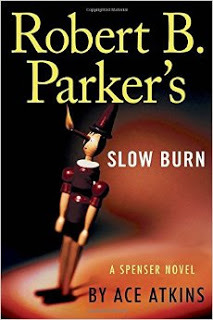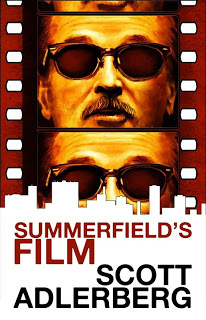David Cranmer's Blog, page 49
May 5, 2016
Under Burning Skies: Four Faces West, Monte Walsh, The Grave of Marcus Pauly
Four Faces West (film, 1948)
Ross McEwen (Joel McCrea) robs a bank in Santa Maria, New Mexico, and kidnaps the banker then releases him a few miles away. In an odd twist, he leaves an IOU for the $2000 he pilfered. The banker hikes back to town to alert newly elected Sheriff Pat Garrett (Charles Bickford) who leads a posse after McEwan. Along the way McEwan is helped by, and falls in love with, a nurse named Faye Hollister (Frances Dee, aka Mrs. Joel McCrea). Observing their budding romance is a gambler, Monte Marquez (Joseph Calleia), who realizes who McEwan is and may or may not hanker for the reward on the wanted man’s head. Reflective, moving gem that is based on the book Paso Por Aqui by Eugene Manlove Rhodes and for whom the film is dedicated. Joel McCrea's every man, likable persona resounds even better now than it did in the mid-twentieth century. A rancher in real life who, after the success of The Virginian in 1946, exclusively made Westerns (with one exception) for the rest of his career.
Film flub: IMDb notes that when McEwan gets bit by the rattler, it's concealed inside the bushes. But a second later, with no time to slither away, the snake is seen in open ground.
Monte Walsh (TV film, 2003)
In this remake of the 1970 Lee Marvin film, Isabella Rosselini, playing the part of “Countess” Martine, says to Tom Selleck’s Monte Walsh: “Monte, as time goes by, we all have to take the best we can get. Perhaps one day you will find that the same applies to you.” Monte replies, “Well, I ain’t changing.”
It’s a familiar plot: the 19th-century cowboy having trouble accepting the inevitable fact that times are indeed passing him by. Writer Jack Schaefer explored a similar theme in his earlier and more famous Shane. However, at the end of that classic, the hero rides off into the night and fade-out. In a way, Monte Walsh picks up where that film left off and follows the story of what became of men like Shane. Hardships abound as Monte continues to try to make a living when fewer and fewer options remain as railways, barbed wire, etc., become more widespread. A defiant Monte tells a fellow hombre that as long as there is one cow and one cowboy, it ain’t over.
The Grave of Marcus Pauly (novella, 2011) by Wayne D. Dundee
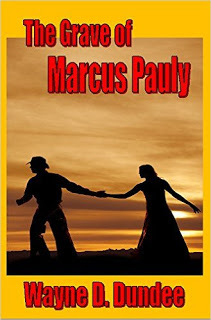
Annabelle Heath arrives in the town of Busted Bow looking for Ford Ramsey, an ex-con who rode with her uncle Marcus Pauly robbing banks shortly after the Civil War. Her aim is to ask Ramsey's help in locating Pauly's remains, somewhere in the rugged territory, so she can take them back to Missouri for a proper burial—which were her mother's last wishes. Of course, that will be anything but easy especially when Ramsey starts to suspect someone is following them, someone who may want the money that many believe Ramsey hid before being sent to prison. A highlight of The Grave of Marcus Pauly is the friendship that develops between the earnest but naïve Annabelle and the hardened former convict determined to finally do the right thing. Wayne D. Dundee (Manhunter’s Mountain, The Empty Badge) tells the story in his steady, unassuming, rhythmic precision that doesn’t let up until the final page.
Ross McEwen (Joel McCrea) robs a bank in Santa Maria, New Mexico, and kidnaps the banker then releases him a few miles away. In an odd twist, he leaves an IOU for the $2000 he pilfered. The banker hikes back to town to alert newly elected Sheriff Pat Garrett (Charles Bickford) who leads a posse after McEwan. Along the way McEwan is helped by, and falls in love with, a nurse named Faye Hollister (Frances Dee, aka Mrs. Joel McCrea). Observing their budding romance is a gambler, Monte Marquez (Joseph Calleia), who realizes who McEwan is and may or may not hanker for the reward on the wanted man’s head. Reflective, moving gem that is based on the book Paso Por Aqui by Eugene Manlove Rhodes and for whom the film is dedicated. Joel McCrea's every man, likable persona resounds even better now than it did in the mid-twentieth century. A rancher in real life who, after the success of The Virginian in 1946, exclusively made Westerns (with one exception) for the rest of his career.
Film flub: IMDb notes that when McEwan gets bit by the rattler, it's concealed inside the bushes. But a second later, with no time to slither away, the snake is seen in open ground.
Monte Walsh (TV film, 2003)
In this remake of the 1970 Lee Marvin film, Isabella Rosselini, playing the part of “Countess” Martine, says to Tom Selleck’s Monte Walsh: “Monte, as time goes by, we all have to take the best we can get. Perhaps one day you will find that the same applies to you.” Monte replies, “Well, I ain’t changing.”
It’s a familiar plot: the 19th-century cowboy having trouble accepting the inevitable fact that times are indeed passing him by. Writer Jack Schaefer explored a similar theme in his earlier and more famous Shane. However, at the end of that classic, the hero rides off into the night and fade-out. In a way, Monte Walsh picks up where that film left off and follows the story of what became of men like Shane. Hardships abound as Monte continues to try to make a living when fewer and fewer options remain as railways, barbed wire, etc., become more widespread. A defiant Monte tells a fellow hombre that as long as there is one cow and one cowboy, it ain’t over.
The Grave of Marcus Pauly (novella, 2011) by Wayne D. Dundee

Annabelle Heath arrives in the town of Busted Bow looking for Ford Ramsey, an ex-con who rode with her uncle Marcus Pauly robbing banks shortly after the Civil War. Her aim is to ask Ramsey's help in locating Pauly's remains, somewhere in the rugged territory, so she can take them back to Missouri for a proper burial—which were her mother's last wishes. Of course, that will be anything but easy especially when Ramsey starts to suspect someone is following them, someone who may want the money that many believe Ramsey hid before being sent to prison. A highlight of The Grave of Marcus Pauly is the friendship that develops between the earnest but naïve Annabelle and the hardened former convict determined to finally do the right thing. Wayne D. Dundee (Manhunter’s Mountain, The Empty Badge) tells the story in his steady, unassuming, rhythmic precision that doesn’t let up until the final page.
Published on May 05, 2016 17:48
Gritty They Say...
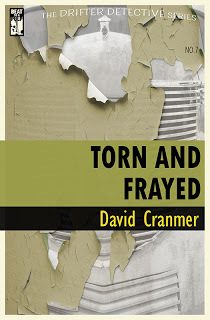 Nice way to end the day: "Gritty, moody and atmospheric with bursts of action punctuating the tale." New review on my TORN AND FRAYED novella.
Nice way to end the day: "Gritty, moody and atmospheric with bursts of action punctuating the tale." New review on my TORN AND FRAYED novella.
Published on May 05, 2016 14:14
May 4, 2016
Vesper Lynd
Published on May 04, 2016 14:17
May 3, 2016
Slow Burn by Ace Atkins
Published on May 03, 2016 14:44
May 1, 2016
Under Burning Skies: The Man Who Shot Liberty Valance, Junior Bonner, Waiting for a Comet
THE MAN WHO SHOT LIBERTY VALANCE (film, 1962)
Senator Ransom “Ranse” Stoddard (James Stewart) and wife Hallie (Vera Miles) return to the town of Shinbone to attend the funeral of old friend Tom Doniphon (John Wayne). Through a flashback we learn of what ties them altogether—specifically the sadistic villain Liberty Valance played by Lee Marvin. What more can be said about this John Ford directed classic except with each passing year a central theme of guns vs. law continues to be debated in parts of this county which is sad to my way of thinking. Film shot in stark black and white only ages in some of its hackneyed comic subplots, usually involving the coward sheriff (Andy Devine) or drunken town editor (Edmond O’Brien). Interesting to note Ford’s subtle presentation of African American Pompey (Woody Strode) who is shown on the community’s fringes like an observant, silent, all-knowing arbitrator: not saying the film was the gold standard of progressive thinking but it was a necessary step in the right direction.
Classic quote: “When the legend becomes fact, print the legend.”
JUNIOR BONNER (film, 1972)
Steve McQueen plays a modern Western cowboy as a rodeo champion Junior ”JR“ Bonner who returns to Prescott, Arizona, to reunite with his parents and brother and ride the unruly bull, Sunshine. Junior turns down a job from his arrogant salesman brother Curly by saying, “I gotta go down my own road.” “What road?” Curly replies, “I mean, I'm workin' on my first million, and you're still workin' on eight seconds.” The film bombed at the box office—director Sam Peckinpah remarked, ”I made a film where nobody got shot and nobody went to see it.”—but it’s now considered a film classic. A rousing crowded bar-room scene where the entire Bonner family and friends end up brawling but nobody is seriously injured is a hoot.
Note: I review Steve McQueen: The King of Cool Westerns at Macmillan’s Criminal Element blog.
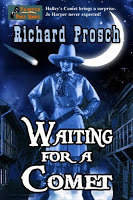 WAITING FOR A COMET (Jo Harper Book 1, 2014) by Richard Prosch
WAITING FOR A COMET (Jo Harper Book 1, 2014) by Richard Prosch
Jo Harper is a twelve-year-old girl. She and her father, the publisher of the Willowby Monitor in Wyoming circa 1910, live alone after Jo's mother died years earlier. Things change when new constable Abigail Drake arrives with her pet calf. Jo finds a friend/mentor in Abigail and an unlikely adventure is in the works. A real joy to read this Y/A slice of Americana in the Mark Twain tradition who's referenced in the book (fellow Western author Wayne D. Dundee links similarities to Rooster Cogburn). Richard Prosch's (Holt Country Law, Devil’s Ledger) natural storytelling abilities hits all the emotional notes in this entertaining tale that adults as well as teens will find engaging.
Senator Ransom “Ranse” Stoddard (James Stewart) and wife Hallie (Vera Miles) return to the town of Shinbone to attend the funeral of old friend Tom Doniphon (John Wayne). Through a flashback we learn of what ties them altogether—specifically the sadistic villain Liberty Valance played by Lee Marvin. What more can be said about this John Ford directed classic except with each passing year a central theme of guns vs. law continues to be debated in parts of this county which is sad to my way of thinking. Film shot in stark black and white only ages in some of its hackneyed comic subplots, usually involving the coward sheriff (Andy Devine) or drunken town editor (Edmond O’Brien). Interesting to note Ford’s subtle presentation of African American Pompey (Woody Strode) who is shown on the community’s fringes like an observant, silent, all-knowing arbitrator: not saying the film was the gold standard of progressive thinking but it was a necessary step in the right direction.
Classic quote: “When the legend becomes fact, print the legend.”
JUNIOR BONNER (film, 1972)
Steve McQueen plays a modern Western cowboy as a rodeo champion Junior ”JR“ Bonner who returns to Prescott, Arizona, to reunite with his parents and brother and ride the unruly bull, Sunshine. Junior turns down a job from his arrogant salesman brother Curly by saying, “I gotta go down my own road.” “What road?” Curly replies, “I mean, I'm workin' on my first million, and you're still workin' on eight seconds.” The film bombed at the box office—director Sam Peckinpah remarked, ”I made a film where nobody got shot and nobody went to see it.”—but it’s now considered a film classic. A rousing crowded bar-room scene where the entire Bonner family and friends end up brawling but nobody is seriously injured is a hoot.
Note: I review Steve McQueen: The King of Cool Westerns at Macmillan’s Criminal Element blog.
 WAITING FOR A COMET (Jo Harper Book 1, 2014) by Richard Prosch
WAITING FOR A COMET (Jo Harper Book 1, 2014) by Richard Prosch Jo Harper is a twelve-year-old girl. She and her father, the publisher of the Willowby Monitor in Wyoming circa 1910, live alone after Jo's mother died years earlier. Things change when new constable Abigail Drake arrives with her pet calf. Jo finds a friend/mentor in Abigail and an unlikely adventure is in the works. A real joy to read this Y/A slice of Americana in the Mark Twain tradition who's referenced in the book (fellow Western author Wayne D. Dundee links similarities to Rooster Cogburn). Richard Prosch's (Holt Country Law, Devil’s Ledger) natural storytelling abilities hits all the emotional notes in this entertaining tale that adults as well as teens will find engaging.
Published on May 01, 2016 08:16
April 29, 2016
Scott Adlerberg's Winning Streak Continues
Published on April 29, 2016 17:29
April 28, 2016
Under Burning Skies: The Americano, Hombre, and Backshot
The Americano (1955, film)
You have to love low-budget RKO Pictures for always throwing in everything but the kitchen sink. In the first thirty minutes of The Americano, Glenn Ford on a trip to sell three Brahman bulls in Brazil, encounters piranhas, crocodiles, mountain lions, snakes, and a desperado named el Gato played by Cesar Romero! Silly, undemanding, pulp Western grounded by the ever reliable Ford and mucho on-location filming of Brazil that’s astounding to behold. But, without a doubt, Romero steals every scene, and as I watched The Americano I realized I would rather be watching a story about the colorful el Gato.
Film flub: Ford’s horse quite clearly changes back and forth between two different animals.
Hombre (1967, film)
Paul Newman is John Russell, reared for a period by Apaches and now as an adult would prefer to live with them. He returns to the land of the white man when his biological father dies leaving a boardinghouse to John. Traveling by stagecoach with the standard cliché of passengers (Hollywood is all but unpredictable) they are held up by Cicero Grimes (menacing perfection by Have Gun, Will Travel’s Richard Boone) and it’s up to John to lead them to safety. This socially conscious Western has aged well thanks to a strong cast that also includes Richard March, Martin Balsam, and Diane Cilento.
Trivia: The photo that closes the film is that of Jimmy Santiago McKinn captured by Apaches in 1885.
Backshot (2015, novel) by Ed Gorman
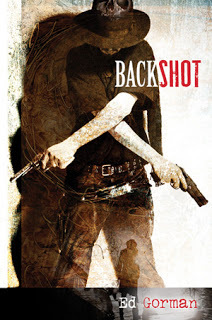 Parnell is a ne’er-do-well who has pissed off his last friend in the town of Granite Bend with his mounting gambling debts. When his corrupt boss and the woman he longs for plan to rob a judge of a wealthy coin collection, he figures he has nothing to lose by throwing in with their scheme. But then nothing goes as they planned in this authentic Western that steers clear of mythological posturing. The jacket blurb of Backshot states “in the tradition of Charles Willeford noir Westerns.” Future practitioners of this subgenre will be likened to Ed Gorman—a master of crafting Westerns dripping with raw human emotions.
Parnell is a ne’er-do-well who has pissed off his last friend in the town of Granite Bend with his mounting gambling debts. When his corrupt boss and the woman he longs for plan to rob a judge of a wealthy coin collection, he figures he has nothing to lose by throwing in with their scheme. But then nothing goes as they planned in this authentic Western that steers clear of mythological posturing. The jacket blurb of Backshot states “in the tradition of Charles Willeford noir Westerns.” Future practitioners of this subgenre will be likened to Ed Gorman—a master of crafting Westerns dripping with raw human emotions.
Note: another superb Ed Gorman story is Relentless that I reviewed for Macmillan’s Criminal Element blog.
You have to love low-budget RKO Pictures for always throwing in everything but the kitchen sink. In the first thirty minutes of The Americano, Glenn Ford on a trip to sell three Brahman bulls in Brazil, encounters piranhas, crocodiles, mountain lions, snakes, and a desperado named el Gato played by Cesar Romero! Silly, undemanding, pulp Western grounded by the ever reliable Ford and mucho on-location filming of Brazil that’s astounding to behold. But, without a doubt, Romero steals every scene, and as I watched The Americano I realized I would rather be watching a story about the colorful el Gato.
Film flub: Ford’s horse quite clearly changes back and forth between two different animals.
Hombre (1967, film)
Paul Newman is John Russell, reared for a period by Apaches and now as an adult would prefer to live with them. He returns to the land of the white man when his biological father dies leaving a boardinghouse to John. Traveling by stagecoach with the standard cliché of passengers (Hollywood is all but unpredictable) they are held up by Cicero Grimes (menacing perfection by Have Gun, Will Travel’s Richard Boone) and it’s up to John to lead them to safety. This socially conscious Western has aged well thanks to a strong cast that also includes Richard March, Martin Balsam, and Diane Cilento.
Trivia: The photo that closes the film is that of Jimmy Santiago McKinn captured by Apaches in 1885.
Backshot (2015, novel) by Ed Gorman
 Parnell is a ne’er-do-well who has pissed off his last friend in the town of Granite Bend with his mounting gambling debts. When his corrupt boss and the woman he longs for plan to rob a judge of a wealthy coin collection, he figures he has nothing to lose by throwing in with their scheme. But then nothing goes as they planned in this authentic Western that steers clear of mythological posturing. The jacket blurb of Backshot states “in the tradition of Charles Willeford noir Westerns.” Future practitioners of this subgenre will be likened to Ed Gorman—a master of crafting Westerns dripping with raw human emotions.
Parnell is a ne’er-do-well who has pissed off his last friend in the town of Granite Bend with his mounting gambling debts. When his corrupt boss and the woman he longs for plan to rob a judge of a wealthy coin collection, he figures he has nothing to lose by throwing in with their scheme. But then nothing goes as they planned in this authentic Western that steers clear of mythological posturing. The jacket blurb of Backshot states “in the tradition of Charles Willeford noir Westerns.” Future practitioners of this subgenre will be likened to Ed Gorman—a master of crafting Westerns dripping with raw human emotions.Note: another superb Ed Gorman story is Relentless that I reviewed for Macmillan’s Criminal Element blog.
Published on April 28, 2016 16:29
April 27, 2016
One Man's Opinion
Published on April 27, 2016 14:01
FROM DUNDEE'S DESK: Noteworthy Reads: MAGE, MAZE, DEMON by Charles All...
FROM DUNDEE'S DESK: Noteworthy Reads: MAGE, MAZE, DEMON by Charles All...: When it comes to writing heroic fantasy --- or sword and sorcery, if you will --- nobody captures the drive and raw energy of the lat...
Published on April 27, 2016 13:19
April 26, 2016
Dust Up
I feel obliged, for the first time, to insert myself into the proceedings. Back in 1994, as a military policeman in the US Army, I was deployed to Haiti as part of President Clinton’s Operation Uphold Democracy to return Jean-Bertrand Aristide to power. From the instant we landed at the airport to cheering crowds, I was taken in with the kind people who were non-reticent in approaching us with thanks and their desire to share thoughts on their country. Reading Dust Up took me...
Published on April 26, 2016 12:30


